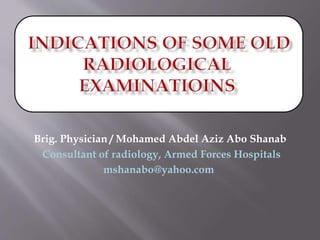
PRESENTATION. old rad techniques.pptx
- 1. Brig. Physician / Mohamed Abdel Aziz Abo Shanab Hospitals Consultant of radiology, Armed Forces mshanabo@yahoo.com
- 2. Old imaging techniques that are rarely used are different from Historical imaging techniques, such as Bronchography Chest photofluorography Conventional tomography Pneumoencephalography Translumbar aortography
- 3. The field of diagnostic and therapeutic radiology has always been characterized by constant innovation & creativity to evolve to its current form. There are numerous imaging techniques that were once prevalent but have become outdated & replaced by the current examinations and modalities, which improve diagnostic accuracy and patient outcomes.
- 4. Knowledge of these old radiologic examinations and procedures is important to understand how we have arrived at the current practice of radiology & how our field can continue to evolve to improve our diagnostic and therapeutic abilities to fit the changing needs of our patients.
- 5. Fluoroscopy uses X-rays to capture an image of an organ while it is functioning. It includes both lower and upper GITs. A lower GI is an X-ray evaluation of the large intestine (the colon). This includes the right or ascending colon, the transverse colon, the left or descending colon and the rectum.
- 6. An upper GI Study is an X-ray examination of the esophagus, stomach and first part of the small intestine. Upper GIT must be coated or filled with a contrast material called barium, an element that appears bright white on radiographs.
- 7. The barium is given to the patient to drink. Some patients are asked to swallow baking- soda crystals to create gas and further improve the images; this procedure has the modified name of air-contrast or double- contrast upper GI.
- 9. Esophogram Barium Meal, UGI Series Barium Follow through, Small Bowel and UGI Barium Enema
- 11. The dedicated small bowel follow-through has been replaced to a lesser degree by CT Abdomen, CT and MR Enterography & capsule endoscopy. For lower GI symptoms and colon cancer screening, the double-contrast barium enema has increasingly been discarded in favor of Colonoscopy, CT Abdomen, CT Colonography.
- 12. Barium studies are considered by radiologists as a “low-tech” form of imaging. CT and MR, are seen more appealing “high- tech” imaging modalities. Barium studies are also physically taxing, labor-intensive procedures and, arguably, one of the more difficult skill sets for radiologists to master.
- 13. Decline of barium radiology, Alarm Barium studies are highly operator dependent. No Sufficient Instructors to train residents Performance needs training, experience and expertise in barium radiology This is another disincentive for clinicians to order barium studies in community practice.
- 15. IVP Cystogram IVP with Tomograms Retrograde Pyelogram
- 16. An Intravenous Pyelogram (IVP) is an x-ray examination of the kidneys, ureters, and urinary bladder. An IVP study uses a contrast material to enhance urinary structures in x-ray images. The iodine contrast material is injected into the patient's venous system, and its progress through the urinary tract is then recorded on a series of quickly captured images. Show the anatomy & function of the kidneys and urinary tract.
- 18. Renal colic Renal stone disease Calyceal pathology Hematuria Chronic upper urinary tract obstruction. The commonest situation in which the CTU & MRU are now being suggested as an alternative to an IVU is in the investigation of suspected renal colic.
- 19. Radiation dosage:- - 3-shot IVU 1.5 mSv (millisievert). - Unenhanced CT 4.5 mSv CT scan, performed within few minutes. IVU need delayed films, may prolong the examination for more than 12 h.
- 20. IVP vs CT CTU detection for the cause of haematuria is high (sensitivity 92 - 100 %, specificity 89 - 97 %) & significantly better than IVP (sensitivity 61 %, specificity 97 %). Radiation doses of IVP < CT but varies with the number of films Many practices no longer have tomographic equipment. Many " younger " radiologists have never performed or interpreted an IVP
- 23. IVP may be inconvenient to the patient as its procedures include, puncture by cannula (pain), allergy to contrast medium,
- 24. It is interesting to speculate about which of the imaging modalities and techniques we rely on today will become the antiquated examinations of the future!! AI may replace jobs, personnel as radiologists in the future!
- 25. THANK YOU